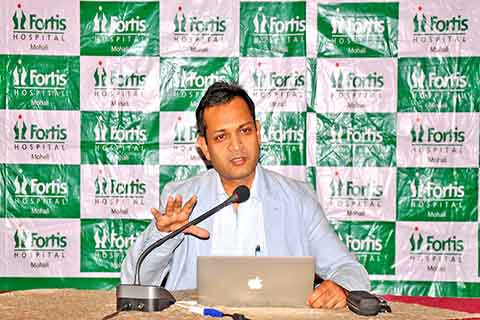 Dr Ravul Jindal, Director Vascular Surgery at Fortis Hospital Mohali, Punjab Monday said that studies show the number of people diagnosed with diabetes and those at a risk of the disease is increasing in Kashmir.
Dr Ravul Jindal, Director Vascular Surgery at Fortis Hospital Mohali, Punjab Monday said that studies show the number of people diagnosed with diabetes and those at a risk of the disease is increasing in Kashmir.
While addressing media persons in a local hotel here, he said that diabetic foot care is one of the most ignored aspects of diabetic care in India.
“Studies show that the number of people diagnosed with diabetes and those at a risk of the disease is increasing in Kashmir. Lack of awareness is a huge factor,” Dr Jindal said, adding that the number of diabetics have increased manifold in the past three decades.
Quoting a study published in Journal of Bio Medical Research titled “Risk factors of type 2 diabetes in population of Jammu and Kashmir,” he said: “The growth of middle class in Jammu and Kashmir is leading to the availability of high caloric junk food. At the same time, as the availability of resources, comfortable transportation facilities increase, the physical activity is reduced with long hours of bench work.”
“We have been trying to raise awareness regarding diabetic foot. This is another such initiative so that people can benefit from advancing medical science. At Fortis Mohali, we receive around 80 new patients per month with diabetic foot and with advanced techniques of infra popliteal angioplasty and advanced foot and wound care we can save more than 90% of these feet from major amputations,” he added.
Warning against the conditions that lead to foot amputation, Dr Jindal said black toes in diabetics may not only be the onset of gangrene leading to foot amputation but also be the knock of heart ailments.
“In India, 41 million people suffer from diabetes, which will rise to 79 million in 2030. Apart from the high incidence of diabetes, age at which it occurs in the Indian population is a cause of great concern. In India about 40,000 limbs are amputated every year because of diabetes-related foot complications,” he added.
He said that amputation due to diabetic foot can be prevented in 90 percent of cases with proper education and timely treatment. “If not treated in time, patients run the risk of foot or leg amputation. This carries a huge morbidity and mortality risk as these patients also have associated heart disease,” he added.
He said that smokers having associated diabetes are more prone to gangrene than smokers or diabetics alone.
The absence of early diagnosis worsens the problem. “Though there are no figures for vascular patients in country, the fact that there are over 25 million diabetics is just a small pointer to vast number of undiagnosed vascular cases. Studies show that patients of severe vascular disease have been treated for low backache and arthritis for years,” he said.
He said that while majority of diabetics in developed countries are 65 years and older, most diabetics in India range between 45 and 65 years of age and approximately 15 percent of diabetics patients suffer from foot problems. “Since it is productive age group, disease burden in this age group has huge socio-economic impact,” he added.
Diabetic foot can lead to limb amputation: Dr Jindal




